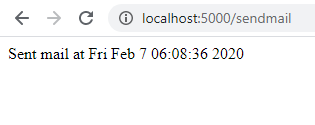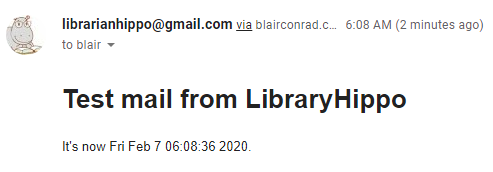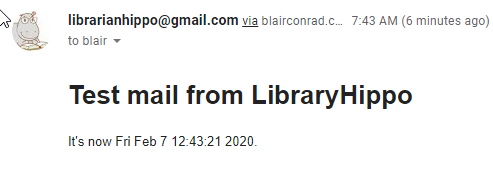LibraryHippo 2020 - Sending Email from Heroku
After getting a do-nothing web app running on Heroku, I think the riskiest requirement is having a scheduled job for LibraryHippo to check families' status and notify them. However rather than trying to satisfy that requirement, this time I'm going to try to set up email sending, mostly because it can be used as the triggered action, making it easier to test the scheduled jobs.
Requirements
Flask has a plugin to make sending mail easier,
Flask-Mail; I'll install it, but first
I'll add a task to freeze the requirements.txt file, since I'm tired of
using the Powershell syntax to do that.
# tasks.py
@task
def freeze(c):
"""Freeze pip's requirements.txt. Does not commit the file."""
import pip
result = c.run("pip freeze")
with open("requirements.txt", mode="w") as requirements:
requirements.write(result.stdout)Now to install the package:
❯ pip install Flask-Mail
❯ inv freeze
Collecting Flask-Mail
Using cached Flask-Mail-0.9.1.tar.gz (45 kB)
Requirement already satisfied: Flask in d:\sandbox\libraryhippo\venv\lib\site-packages (from Flask-Mail) (1.1.1)
Collecting blinker
Using cached blinker-1.4.tar.gz (111 kB)
Requirement already satisfied: itsdangerous>=0.24 in d:\sandbox\libraryhippo\venv\lib\site-packages (from Flask->Flask-Mail) (1.1.0)
Requirement already satisfied: Werkzeug>=0.15 in d:\sandbox\libraryhippo\venv\lib\site-packages (from Flask->Flask-Mail) (0.16.1)
Requirement already satisfied: Jinja2>=2.10.1 in d:\sandbox\libraryhippo\venv\lib\site-packages (from Flask->Flask-Mail) (2.11.1)
Requirement already satisfied: click>=5.1 in d:\sandbox\libraryhippo\venv\lib\site-packages (from Flask->Flask-Mail) (7.0)
Requirement already satisfied: MarkupSafe>=0.23 in d:\sandbox\libraryhippo\venv\lib\site-packages (from Jinja2>=2.10.1->Flask->Flask-Mail) (1.1.1)
Installing collected packages: blinker, Flask-Mail
Running setup.py install for blinker ... done
Running setup.py install for Flask-Mail ... done
Successfully installed Flask-Mail-0.9.1 blinker-1.4
blinker==1.4
Click==7.0
Flask==1.1.1
Flask-Mail==0.9.1
gunicorn==20.0.4
invoke==1.4.1
itsdangerous==1.1.0
Jinja2==2.11.1
MarkupSafe==1.1.1
python-dotenv==0.10.5
Werkzeug==0.16.1Flask-Mail Configuration
The production LibraryHippo application uses Sendgrid
as an email server, and I see no reason to deviate now. Flask-Mail must be
configured to use this server. Some of the configuration should remain a secret
(the password), and some could be hard-coded right in the app, but I prefer to
separate the configuration from the code. I'll put the public settings in a file
called configuration, which will be committed, and the sensitive ones in
secrets, which I won't commit.
# configuration
MAIL_DEFAULT_SENDER=librarianhippo@gmail.com
MAIL_PORT=587
MAIL_SERVER=smtp.sendgrid.net
MAIL_USE_TLS=True
MAIL_USERNAME=apikey# secrets
# Do not commit this file. It must not be shared.
MAIL_PASSWORD=AN_API_KEY_THAT_I_WONT_SHARE_WITH_YOUCode
Now to make Flask aware of the configuration from above and to add Flask-Mail to the application so it can send email.
The Config class is a bridge that gives Flask access to the environment variables. It
- provides a central location to view all configuration settings
- supplies sensible defaults for settings that might have some, and
- converts some settings from strings to their proper types, simplifying usage in the code.
# config.py
import os
from dotenv import load_dotenv
basedir = os.path.abspath(os.path.dirname(__file__))
load_dotenv(os.path.join(basedir, "secrets"))
load_dotenv(os.path.join(basedir, "configuration"))
class Config(object):
MAIL_DEFAULT_SENDER = os.environ.get("MAIL_DEFAULT_SENDER")
MAIL_PASSWORD = os.environ.get("MAIL_PASSWORD")
MAIL_PORT = int(os.environ.get("MAIL_PORT") or 25)
MAIL_SERVER = os.environ.get("MAIL_SERVER")
MAIL_USE_TLS = os.environ.get("MAIL_USE_TLS") != "False"
MAIL_USERNAME = os.environ.get("MAIL_USERNAME")Then 4 lines are added to the application initialization to hook the configuration class and Flask-Mail into the application:
# app/__init__.py
from config import Config
from flask import Flask
from flask_mail import Mail
app = Flask(__name__)
app.config.from_object(Config)
mail = Mail(app)
from app import routesFinally, a new route is added to the application to trigger the email. Note that this is completely unprotected and a horrible, horrible idea for a production environment, as someone could just visit the page and spam me. But it makes for an easy test.
# routes.py
from app import app
from app import mail
from datetime import datetime
from flask_mail import Message
@app.route("/sendmail")
def sendmail():
now = datetime.now().strftime("%c")
msg = Message("Mail from LibraryHippo", recipients=["[email protected]"])
msg.body = f"test mail from LibraryHippo at {now}"
msg.html = f"<h1>Test mail from LibraryHippo</h1><p>It's now {now}."
mail.send(msg)
return f"Sent mail at {now}"And it works! I can trigger the route and get a success message. Nearly instantaneously, I receive the email in my inbox.
❯ inv run
* Serving Flask app "libraryhippo.py"
* Environment: production
WARNING: This is a development server. Do not use it in a production deployment.
Use a production WSGI server instead.
* Debug mode: off
* Running on http://127.0.0.1:5000/ (Press CTRL+C to quit)
127.0.0.1 - - [07/Feb/2020 06:08:38] "GET /sendmail HTTP/1.1" 200 -

Deploying to Heroku
There's very little work to do to deploy to Heroku. All the new configuration
settings are in the configuration file except for MAIL_PASSWORD. The
Heroku web interface provides a way to set the value, but it's easier to use the
Heroku command line interface:
❯ heroku config:set "MAIL_PASSWORD=AN_API_KEY_THAT_I_WONT_SHARE_WITH_YOU"
Setting MAIL_PASSWORD and restarting ⬢ libraryhippo... done, v4
MAIL_PASSWORD: AN_API_KEY_THAT_I_WONT_SHARE_WITH_YOUAnd now to deploy and test
❯ inv deploy
remote: Compressing source files... done.
remote: Building source:
remote:
remote: -----> Python app detected
remote: -----> Need to update SQLite3, clearing cache
remote: -----> Installing python-3.8.1
remote: -----> Installing pip
remote: -----> Installing SQLite3
remote: Sqlite3 successfully installed.
remote: -----> Installing requirements with pip
#
# a lot of boring pip stuff
#
remote: Successfully installed Click-7.0 Flask-1.1.1 Flask-Mail-0.9.1 Jinja2-2.11.1 MarkupSafe-1.1.1 Werkzeug-0.16.1 blinker-1.4 gunicorn-20.0.4 invoke-1.4.1 itsdangerous-1.1.0 python-dotenv-0.10.5
remote:
remote: -----> Discovering process types
remote: Procfile declares types -> web
remote:
remote: -----> Compressing...
remote: Done: 47.9M
remote: -----> Launching...
remote: Released v5
remote: https://libraryhippo.herokuapp.com/ deployed to Heroku
remote:
remote: Verifying deploy... done.
To https://git.heroku.com/libraryhippo.git
3f0598d..ddf4728 lh2020 -> master

Note the time discrepancy between the time that LibraryHippo reported and the time that GMail said it receive the message. I'm sending from UTC-5, and the Heroku server appears to be in UTC. It's not a problem for now, but may become a factor when scheduling jobs.
Progress
Two of nine requirements have been met.
| requirement | |
|---|---|
| ✓ | web app hosting |
| next | scheduled jobs (run in UTC) |
| scraping library websites on users' behalf | |
| small persistent datastore | |
| social authentication | |
| ✓ | sending e-mail |
| nearly free | |
| job queues | |
| custom domain name |